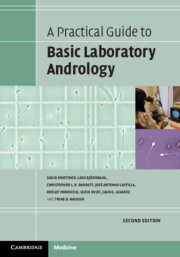Book contents
- A Practical Guide to Basic Laboratory Andrology
- A Practical Guide to Basic Laboratory Andrology
- Copyright page
- Contents
- Abbreviations
- Chapter 1 Introduction
- Chapter 2 Basic Physiology
- Chapter 3 Basic Semen Examination
- Chapter 4 Extended Semen Analysis
- Chapter 5 Sperm DNA
- Chapter 6 Computer-Aided Sperm Analysis
- Chapter 7 Sperm Function Tests
- Chapter 8 Tests of Sperm-Cervical Mucus Interaction
- Chapter 9 Sperm Preparation
- Chapter 10 Sperm Cryopreservation
- Chapter 11 Preparation of Surgically Retrieved Spermatozoa
- Chapter 12 Quality Management and Accreditation
- Chapter 13 Risk Management
- Chapter 14 Reproductive Toxicology
- Chapter 15 Andrology Laboratory Safety
- Book part
- Index
- References
Chapter 3 - Basic Semen Examination
Published online by Cambridge University Press: 16 February 2022
- A Practical Guide to Basic Laboratory Andrology
- A Practical Guide to Basic Laboratory Andrology
- Copyright page
- Contents
- Abbreviations
- Chapter 1 Introduction
- Chapter 2 Basic Physiology
- Chapter 3 Basic Semen Examination
- Chapter 4 Extended Semen Analysis
- Chapter 5 Sperm DNA
- Chapter 6 Computer-Aided Sperm Analysis
- Chapter 7 Sperm Function Tests
- Chapter 8 Tests of Sperm-Cervical Mucus Interaction
- Chapter 9 Sperm Preparation
- Chapter 10 Sperm Cryopreservation
- Chapter 11 Preparation of Surgically Retrieved Spermatozoa
- Chapter 12 Quality Management and Accreditation
- Chapter 13 Risk Management
- Chapter 14 Reproductive Toxicology
- Chapter 15 Andrology Laboratory Safety
- Book part
- Index
- References
Summary
Provides reference methods for all aspects of a basic semen examination that are structured as standard operating procedures (SOPs) for easy use at the bench. Methods are focussed on objectivity, robustness, standardized reporting, controlling the risk of errors, and minimizing measurement uncertainty. Includes ejaculate physical characteristics, volume and pH, sperm concentration, sperm motility, sperm vitality, sperm morphology (including seminal cytology), and the simple detection of peroxidase-positive leukocytes in semen.
Keywords
- Type
- Chapter
- Information
- A Practical Guide to Basic Laboratory Andrology , pp. 34 - 80Publisher: Cambridge University PressPrint publication year: 2022



